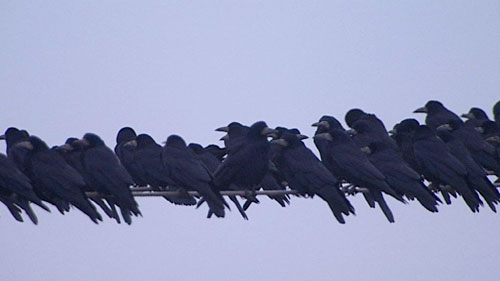 photo from the BBC website.
photo from the BBC website.
by Matthew Vickers.
A winter evening in December. It was very cold; nithering even. As I travelled home I turned off the A607 Grantham Road to follow a favourite short cut via the hamlet of Hough on the Hill. The sun had just set and the unfrozen fields waited to be clamped tight by frost once more.
Just outside the village of Barkston, in fields to the west of the road, a blackening mass hazes and blurs the tramlines of green shoots in the field – Rooks and Jackdaws were gathering before departing to the safety of their night-time roost. The telephone cables were decorated by groups of birds, like notes on a music sheet. Hedges iced with a thick ‘sooting’ of rooks. In the centre of the field the corvid mass jostled, cackled and craw-ed.
More birds arrived from the east, all from the direction of Honington Heath, their arrival silent at first as they glided effortlessly toward the gathering, then when overhead a soft chirring call announces them to the flock below; a series of earthy, primeval caws welcomed the new arrivals. The airborne birds dip one wing and turn earthward, both wings are folded resulting in a balletic tumble and swoop involving several birds criss-crossing each other before they gracefully slip into the flock. More excited vocalisations welcome them as if old acquaintances are greeted and locations of new feeding places are exchanged.
The light fades and the cold bites. Dog walkers eye me with suspicion; the dogs even more so. Both fail to notice the gathering.
The birds on the wires and hedges, on the peripheral of the main group, moved to join the main body. The calls of the Rooks contrast with the sharp “chak” of the Jackdaws. The flock must have numbered more than a thousand birds and still more birds arrived, drifting in from Honington Heath.
The flight lines of roosting rooks are well established; in his book ‘Crow Country’ Mark Cocker investigated the history of one rookery in Scotland. The first written evidence of the rooks (in 1866) records the flight line of the roosting birds; the witness, Mrs Pollock of Dalswinton, describes the spectacle, “the sky would be black with them, their flight overhead would occupy at least an hour and a half – a wide stretch, apparently one hundred and eighty yards. It looked like a river.” Mark Cocker’s research found that ‘another paper’ ‘described the results of a nationwide survey of Scotland’s winter roosts.’ This paper published in 1971 mentions that ‘a nightly flock of 10,000 birds gathered in the village of Dunscore.’ He goes on to point out that ‘as the crow flies, Dunscore is just seconds from Dalwiston.’ Mark Cocker visited the village of Dunscore in 2005 and after enduring a wild and stormy evening he describes that ‘I drove through the village and out again and there was the site and there suddenly were the birds’. In this instance it would appear that this rook roost had been in existence for at least one hundred and fifty years.
At Barkston, as the light faded, the birds began to move closer together. The raucous chatter and squabbles abated, until the whole flock was silent. No longer a large black smudge on the field, instead a tight black, sharp-edged oval has formed, motionless; brooding; waiting for a hidden corvid-signal. Then the black ‘bird-notes’ sat atop a tree on the far side of the field, lifted into the air and headed west. In complete silence the rest of the flock followed and as suddenly as they appeared in the sky they seemed to fade away.
The whole flock headed towards Old Gorse Wood and Mickling Plantation, to the north-west of Barkston. The field was returned to its cotyledon stillness, waiting for the birds to return the next day.
Come springtime, the Rooks and Jackdaws will cease this behaviour and instead will return to their rookeries, but once summer has passed they will flock back to such places, flying along the unseen skylines following their ancestors, night after night, after night.